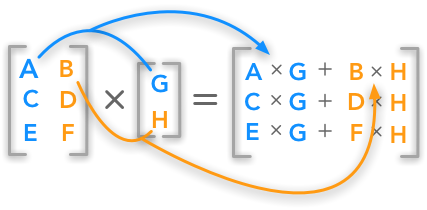Linear algebra#
NumPy includes many functions for linear algebra in the numpy.linalg package.

import numpy as np
Multiplication#
There are several ways to multiply two vectors. The most natural way is the element-wise product. This works precisely how it sounds: multiply two vectors of the same size element-by-element.
In numpy, this operation is performed by the operator *.
x = np.array([2.1, -5.7, 13])
y = np.array([4.3, 9.2, 13])
p = x * y
print(p)
[ 9.03 -52.44 169. ]
Scalar product#
The scalar product is another way to multiply two vectors of the same dimension. Here is how it works: multiply the vectors element-by-element, then add up the result. For two generic column vectors \(\mathbf{x}\in\mathbb{R}^N\) and \(\mathbf{y}\in\mathbb{R}^N\), the scalar product is mathematically defined as
Numpy provides the operator @ and the function np.dot() to do exactly this. It works on arrays of any dimension.
dot = x @ y
print(" x:", x)
print(" y:", y)
print("x@y:", dot)
x: [ 2.1 -5.7 13. ]
y: [ 4.3 9.2 13. ]
x@y: 125.59
Matrix-vector product#
The operator @ is also capable of performing matrix-vector or vector-matrix products. Assume that \(A\in\mathbb{R}^{N\times K}\), \({\bf b}\in\mathbb{R}^{K}\), and \({\bf c}\in\mathbb{R}^{N}\):
Mathematically, the exact operation performed by @ depends on the order of inputs.
A @ bmultiplies the vector \({\bf b}\) by the rows of \(A\):
c @ Amultiplies the vector \({\bf c}\) by the columns of \(A\):
The result is a vector in both cases.
A = np.array([[1,3,1],[2,5,1]])
b = np.array([1, 1, 1])
c = np.array([1, 1])
Ab = A @ b
cA = c @ A
print("--- A ---")
print(A)
print("--- b ---")
print(b)
print()
print("A @ b:", Ab)
print("c @ A:", cA)
--- A ---
[[1 3 1]
[2 5 1]]
--- b ---
[1 1 1]
A @ b: [5 8]
c @ A: [3 8 2]
Matrix product#
When both inputs are matrices, the operator @ performs a matrix multiplication. Specifically, given two matrices \(A\in\mathbb{R}^{M\times N}\) and \(B\in\mathbb{R}^{N\times K}\), their product is equal to the scalar product between the rows of \(A\) and the columns of \(B\):
X = np.array([[1,3,1],[2,5,1]])
Y = np.array([[5,1],[9,2],[14,1]])
Z = X @ Y
print("--- X ---")
print(X)
print("--- Y ---")
print(Y)
print("--- X @ Y ---")
print(Z)
--- X ---
[[1 3 1]
[2 5 1]]
--- Y ---
[[ 5 1]
[ 9 2]
[14 1]]
--- X @ Y ---
[[46 8]
[69 13]]
